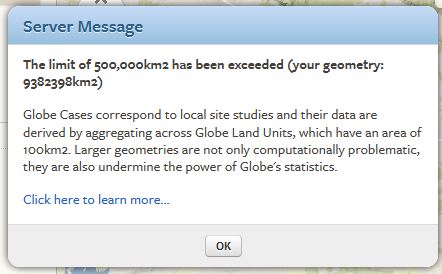Why is my case too big for GLOBE?
So, you were entering your case and got to the part where you were entering a geometry, and then you saw this:
… or something like that. What happened?
Essentially, your case geometry covers too large a spatial extent (>500,000 km2 , ie the size of Spain ) to be considered a case-study in GLOBE. There are several reasons why the GLOBE system implements this size restriction:
1. Large case study geometries are theoretically problematic. Is it valid to compare a field plot with a nation? The fact that analyses at one scale can produce entirely different results when re-run at different scales has been demonstrated many times (e.g. [1-3]). This is especially problematic when the objective of an analysis is to produce general insights about land change regionally or globally from local observations and vice versa. In particular, comparisons and meta-analyses of national or large-scale regional study areas do not capture the heterogeneity that exists at finer spatial scales, and thus are not statistically meaningful for any particular location at smaller spatial scales [4]. Therefore, analyses conducted in GLOBE using large case geometries will produce GLU-level results that are misleading or incorrect.
2. Large case geometries are statistically problematic. The analytical capabilities of GLOBE are built on the underlying data structure of GLUs. In both the similarity and representativeness analyses GLOBE performs, a single value for a given case is compared against single values for all other cases in the analysis. When all cases are cases are one GLU in size, the analysis entails a statistically robust, one-to-one comparison between cases. Even when some of the cases are a few to tens of GLUs in sizes, the analysis still works well. However, if a case is many GLUs (> 100) in size, then two problems emerge: 1) significant aggregation errors are introduced when a case of many GLUs must be represented by a single value, and 2) the comparison of a highly aggregated case value with other smaller cases is misleading and substantially weakens the statistical power of the analysis.
3. Large case geometries are computationally problematic. Whenever a case is entered into GLOBE, there are many statistics that are automatically calculated so that GLOBE’s computational engine can later perform relational and statistical analyses in near real-time. Many of these calculations involve the consideration of every GLOBE Land Unit (GLU) contained within a case geometry against the entire global collection of GLUs. This is not an issue when a case geometries are one or a few GLUs, but when many GLUs are attached to a single case computational barriers are reached.
References
1. Keys, E. and McConnell, W.J. (2005) Global change and the intensification of agriculture in the tropics. Global Environmental Change: Human and Policy Dimensions, 15(4), 320–337.
2. Messerli, P., Heinimann, A., and Epprecht, M. (2009). Finding homogeneity in heterogeneity—a new approach to quantifying landscape mosaics developed for the Lao PDR. Human Ecology, 37(3), 291-304.
3. Verburg, P. H., Neumann, K., and Nol, L. (2011). Challenges in using land use and land cover data for global change studies. Global Change Biology, 17(2), 974-989.
4. Rudel, T.K. (2008) Meta-analyses of case studies: A method for studying regional and global environmental change. Global Environmental Change, 18(1), 18–25.


